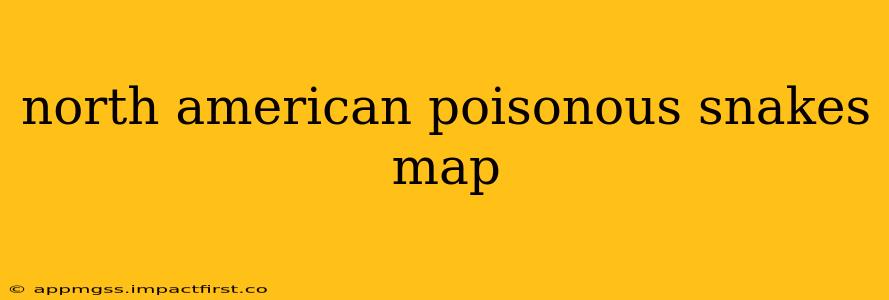North America is home to a diverse range of snakes, some of which are venomous and pose a significant risk to humans. Understanding the geographical distribution of these venomous snakes is crucial for safety and responsible outdoor recreation. This guide provides a comprehensive overview of poisonous snakes in North America, including their habitats and identifying features, along with answers to frequently asked questions. While a detailed map depicting every location of every venomous snake is impossible due to their widespread range and shifting populations, we will cover their general distribution and habitats.
Disclaimer: This information is for educational purposes only. Never attempt to handle a snake you suspect is venomous. If bitten by a snake, seek immediate medical attention.
Identifying Venomous Snakes in North America
Several families of snakes in North America are venomous, but the most important to know are the vipers (family Viperidae) and the elapids (family Elapidae).
-
Viperidae (Pit Vipers): These snakes are characterized by heat-sensing pits between their eyes and nostrils, triangular heads, and vertical pupils. North American pit vipers include rattlesnakes, copperheads, cottonmouths (water moccasins), and pigmy rattlesnakes.
-
Elapidae (Coral Snakes): Coral snakes are less common than pit vipers but are highly venomous. They are characterized by their small heads, round pupils, and vibrant, banded coloration. Identifying coral snakes requires careful attention to detail because several harmless species mimic their coloration.
Geographic Distribution of Venomous Snakes
Precise mapping of every venomous snake's location is not feasible. However, we can delineate general regions where venomous species are most commonly found. Their distribution is largely influenced by climate, habitat availability, and prey populations.
-
Rattlesnakes: Found throughout much of the United States, Mexico, and parts of Canada. They inhabit diverse habitats from deserts and grasslands to forests and mountains.
-
Copperheads: Primarily found in the eastern United States, from the south to the Midwest. They prefer wooded areas, rocky outcrops, and near water sources.
-
Cottonmouths (Water Moccasins): These snakes are found in the southeastern United States, inhabiting swamps, marshes, and along waterways.
-
Coral Snakes: Distributed across the southeastern United States and parts of Mexico. Their habitat preferences vary, but they are often found in areas with loose soil, leaf litter, and hiding places.
Frequently Asked Questions (FAQs)
What are the most common poisonous snakes in North America?
The most common venomous snakes encountered in North America are rattlesnakes (various species), copperheads, and cottonmouths. Coral snakes, while highly venomous, are less frequently encountered.
How can I tell the difference between a poisonous and non-poisonous snake?
This is challenging and should not be attempted without proper training. While some general characteristics like triangular heads (pit vipers) and vertical pupils can be helpful indicators, there are many exceptions. Relying on these alone can be dangerous. Never attempt to handle a snake you are unsure of.
What should I do if I see a poisonous snake?
Maintain a safe distance. Do not attempt to approach, capture, or kill it. Slowly back away and give the snake ample space. If you are in an area with children or pets, guide them away from the snake.
What first aid should I administer if bitten by a poisonous snake?
Do not attempt to suck out the venom. This is a myth and can be harmful. Remain calm, seek immediate medical attention, and try to remember the snake's appearance to help with identification and antivenom treatment.
Are there any poisonous snakes in Canada?
While less prevalent than in the United States, some rattlesnake species are found in southern parts of Canada, particularly British Columbia and possibly extending into Alberta. Their populations are more limited than in the US.
What is the best way to prevent snake bites?
Be aware of your surroundings, especially when hiking or camping in areas known to have venomous snakes. Wear appropriate footwear and clothing that protects exposed skin. Avoid reaching into crevices or areas where snakes might be hiding. Never handle a snake you are unsure of.
This guide provides a general overview. For more detailed information on specific species, consult herpetological resources and local wildlife authorities. Remember, safety and responsible wildlife observation are paramount.
